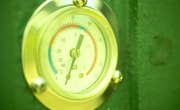When you feel the cool breeze on your face on a scorching hot summer day, in the midst of your relief, it might occur to you to wonder how fast the air is moving, i.e., what the wind speed is. After all, this is how we describe the velocity of air in everyday terms. But what if you want to know the amount of air, an entity you of course cannot see, moving across a particular (perhaps also invisible) boundary at a given time?
The velocity of air in this sense is really air flow. Think of the difference between observing how fast something bobbing in a river moves with the current (the "speed" of the water in the normal sense) and measuring how many gallons of river water move past the point at which you're standing every second (the "velocity of water," or the "flow velocity" or "flow rate").
What is "Air," Anyway?
Air is a fluid, as are liquids such as water. This means that it is continuously physically deformed in a way that solids are not by the application shear stresses, which are pressures that tend to separate the things on which they act by causing the molecules them to in effect "slide" apart along definable boundaries.
Air at the surface if the Earth consists mostly of nitrogen gas (over three-fourths of the atmosphere is made of this element) and oxygen gas (about 20 percent), with smaller amounts of carbon dioxide, methane, water vapor and other trace components.
Why Move Air?
Calculating the flow rate (velocity) of naturally moving air may be of little interest compared to simple wind speed. But when it comes to human-made machines such as ventilators, it is critical to know how much air is being actively transported from one sector to another per unit time.
Ventilators are required in a host of occupational and industrial settings, such as in manufacturing plants where chemicals needed to create the final product are toxic to human systems, in particular the respiratory system.
Velocity of Air Defined
The quantity of air moved per unit time is represented by the equation:
where Q is the velocity of air or its flow rate, A is the cross-sectional area across which the air under study is flowing, and V is the linear velocity of the air, i.e., the average speed at which a given air molecule is moving along in the stream.
If the structure through which air is flowing is a cylindrical tube, for example, the area across which air moves is circular and given by the formula for the area of a circle:
where r is the radius of the cylinder.
Air Flow Calculation from Differential Pressure
If you need to, you can calculate velocity from pressure in these problems if you are given enough information. Pressure differentials between locations are one means by which air is compelled to move from place to place, and the higher the pressure, the higher the flow rate of air.
Pressure has units of force per unit area, but can also be expressed for fluids as density times gravity times height (ρgh) per unit area, because the units come out the same.
Laboratory Equipment
Linear air velocities are classified into low (less than 100 feet per minute) medium (between 100 and 750), and high air velocity (greater than 750). An instrument called a vane anemometer is useful for medium and high air velocities, while a hot-wire anemometer is good for the whole range of velocities, but costs a lot more and is more difficult to maintain.
A smoke tube is cheap and is simple to use, but as you might guess, it is not very accurate and is used primarily to collect the most general data local air movements.
References
Resources
Tips
- You can also obtain density using the perfect gas equation: p = rho * R * T. This is useful if you have a method of measuring temperature directly. Use the measured temperature along with the pressure value from the Standard Atmosphere tables and solve for rho.
Warnings
- If Mach number is greater than 0.3, this method will fail. The equations for flow regimes above M = 0.3 require far more complex calculations.
About the Author
Kevin Beck holds a bachelor's degree in physics with minors in math and chemistry from the University of Vermont. Formerly with ScienceBlogs.com and the editor of "Run Strong," he has written for Runner's World, Men's Fitness, Competitor, and a variety of other publications. More about Kevin and links to his professional work can be found at www.kemibe.com.
